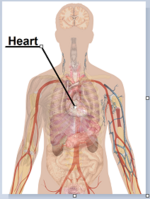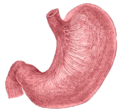Human body diagrams
Main article at: Human body diagrams
Template location:Template:Human body diagrams
How to derive an image
Derive directly from raster image with organs
The raster (.png format) images below have most commonly used organs already included, and text and lines can be added in almost any graphics editor. This is the easiest method, but does not leave any room for customizing what organs are shown.
Adding text and lines:
Derive "from scratch"
By this method, body diagrams can be derived by pasting organs into one of the "plain" body images shown below. This method requires a graphics editor that can handle transparent images, in order to avoid white squares around the organs when pasting onto the body image. Pictures of organs are found on the project's main page. These were originally adapted to fit the male shadow/silhouette.
-
Photograph
-
Shadow/silhouette.
-
Drawing
Organs:
- More organs are found at: Human body diagrams/Organs
-
Intestine
-
Liver
-
Stomach
-
Heart and lungs
-
Rib cage
-
Kidneys
Derive by vector template
The Vector templates below can be used to derive images with, for example, Inkscape. This is the method with the greatest potential.
See Human body diagrams/Inkscape tutorial for a basic description in how to do this.
-
Female photograph
-
Male photograph
Examples of derived works
More examples
-
-
Surface projections of the organs of the trunk
-
-
-
-
-
Health effects of some common types of pollution.
Licensing
 
|
本作品采用知识共享CC0 1.0 通用公有领域贡献许可协议授权。
|
| 采用本宣告发表本作品的人,已在法律允许的范围内,通过在全世界放弃其对本作品拥有的著作权法规定的所有权利(包括所有相关权利),将本作品贡献至公有领域。您可以复制、修改、传播和表演本作品,将其用于商业目的,无需要求授权。
http://creativecommons.org/publicdomain/zero/1.0/deed.enCC0Creative Commons Zero, Public Domain Dedicationfalsefalse
|
| 


































